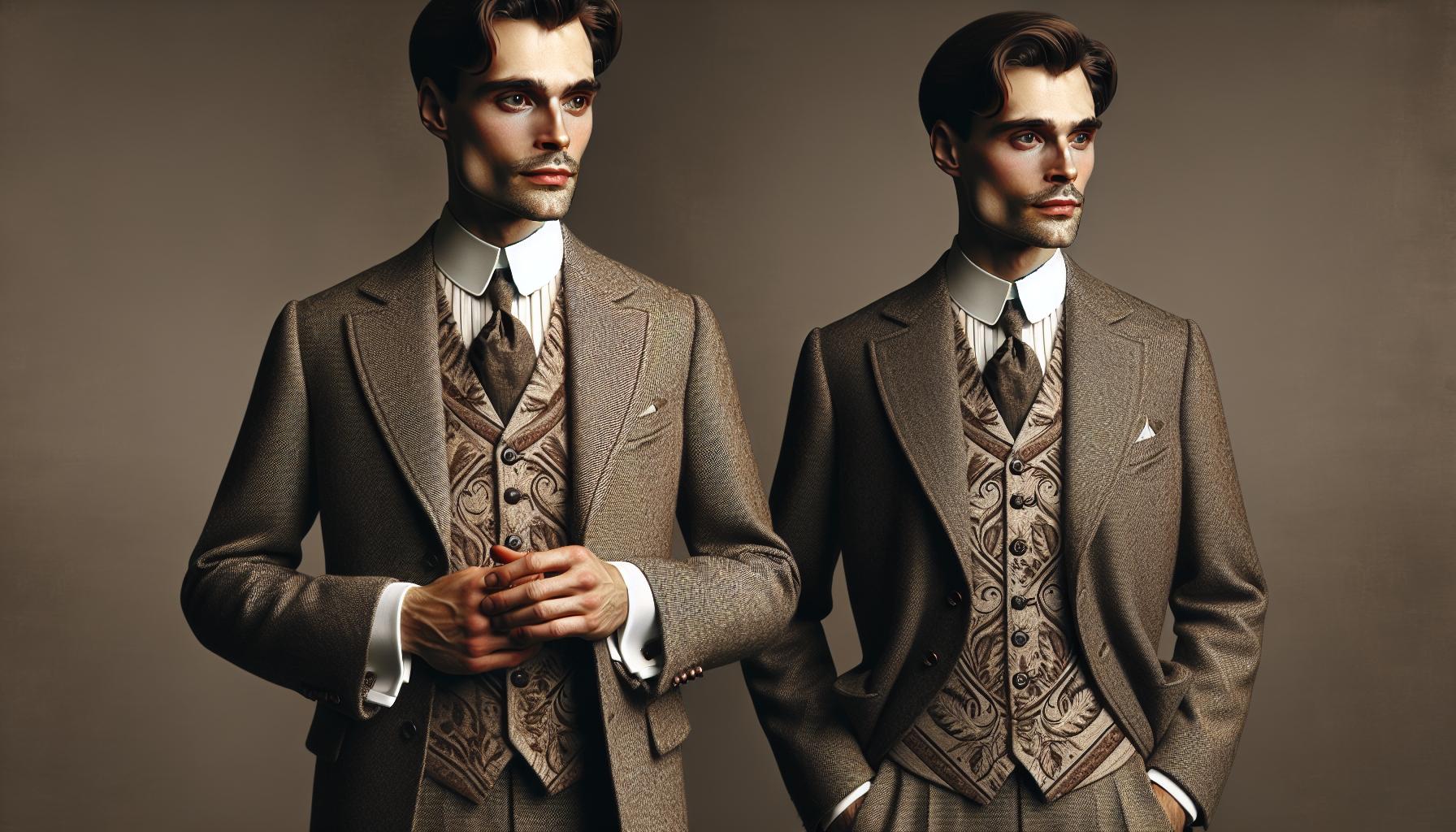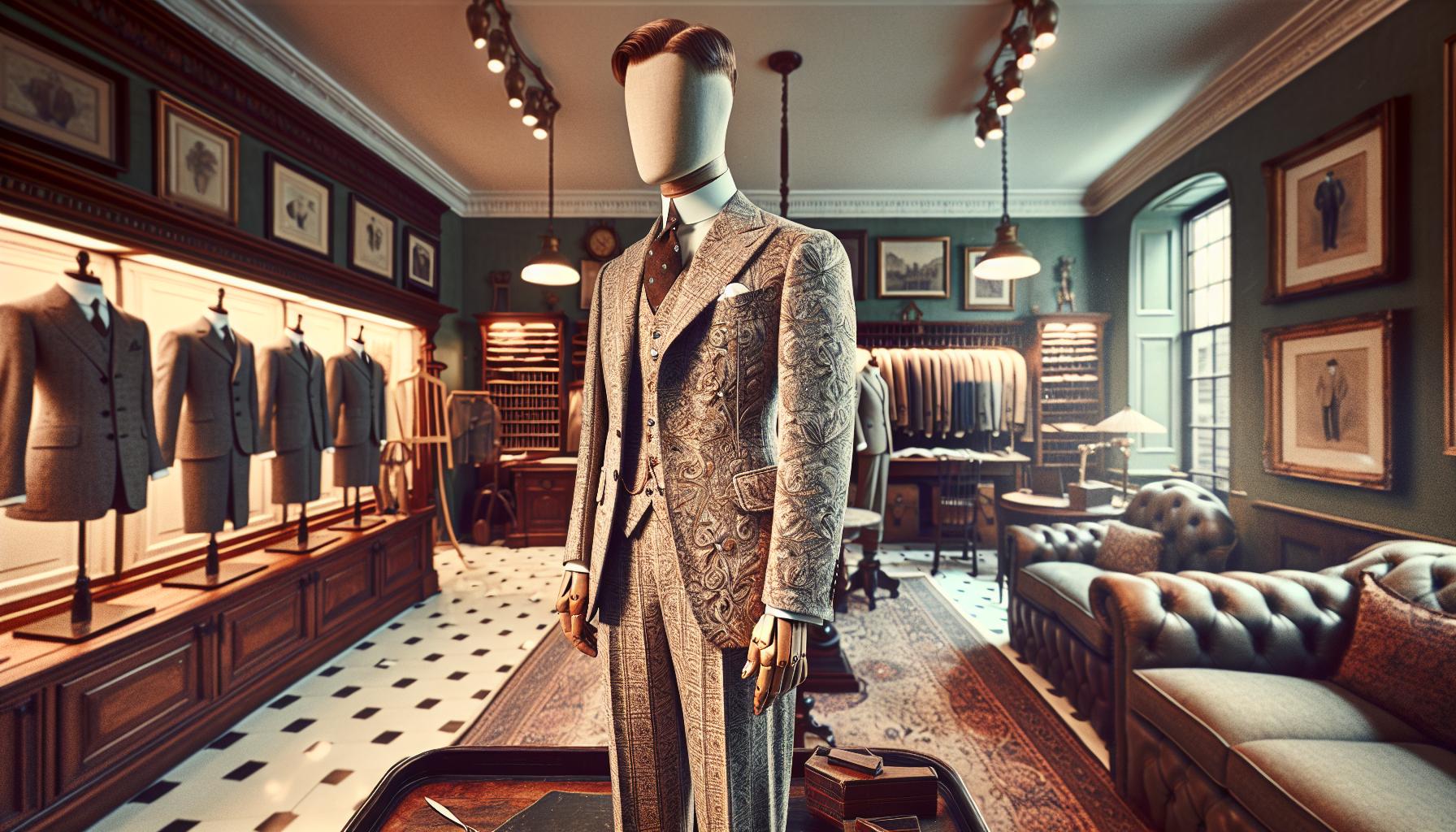Step into the world of 1910 men’s fashion, where dapper gentlemen ruled the streets in style that could make even a peacock blush. Picture this: tailored suits that hugged the waist just right, waistcoats that screamed sophistication, and hats that could double as a small umbrella. Back then, dressing well was not just a choice; it was a way of life, and every man was a potential runway model, whether he was heading to the office or a Sunday picnic.
But let’s not forget the quirks of the era. From the must-have bowler hats to the occasional monocle, 1910 fashion was all about making a statement without saying a word. So grab your finest tweed and prepare to explore the fascinating trends that shaped men’s wardrobes a century ago. It’s time to discover how these timeless styles can still inspire today’s fashion-forward gents.
1910 Men’s Fashion
Men’s fashion in 1910 showcased a blend of elegance and sophistication. Tailored suits featured structured silhouettes, often crafted from wool or tweed. Waistcoats, also known as vests, played a crucial role in achieving a polished look, frequently adorned with intricate patterns.
Distinctive hats characterized the era, with bowler hats and top hats being particularly popular choices. Bowler hats provided a casual yet refined touch, while top hats elevated formalwear to new heights. Accessories like monocles and pocket watches added flair, showcasing personal style.
Shirts typically sported high collars, which emphasized the dapper appearance men aimed to embody. Colors varied widely, with darker hues dominating daily attire, while lighter shades graced summer ensembles. Fabrics such as silk and cotton enhanced comfort and style, accommodating various occasions.
Footwear, often made of leather, included lace-up boots and Oxfords that completed the ensemble. Men prioritized grooming, with well-coiffed hairstyles and neatly trimmed facial hair being standard practices, contributing to the overall polished image.
During this period, men embraced a lifestyle centered on appearance. Fashion choices reflected social status, with wealthier gentlemen opting for bespoke clothing tailored to their specifications. This dedication to style sparked trends that resonate in fashion today, proving the lasting influence of 1910 attire on modern masculinity.
Key Characteristics of 1910 Men’s Fashion

1910 men’s fashion showcased sophistication and refinement through various distinctive elements. The choice of fabrics and materials played a crucial role in defining the era’s style.
Fabrics and Materials
Wool and tweed dominated the fabric landscape, offering durability alongside elegance. Men often wore tailored suits crafted from these materials, which provided a structured silhouette. Additionally, cotton served as a primary fabric for high-collared shirts, enhancing comfort. Linen emerged as a popular choice for summer attire due to its breathability. Heavyweight fabrics frequently characterized outerwear, ensuring warmth during colder months. These luxurious materials contributed to a polished, fashionable appearance that was essential for social interaction.
Colors and Patterns
Diverse color palettes defined 1910 men’s fashion, ranging from deep navy blue to rich burgundy. Stripes and checks gained popularity, with tailored suits often featuring subtle patterns. Monochromatic outfits stood out for their simplicity, emphasizing the importance of understated sophistication. Bright hues occasionally surfaced in waistcoats to add a touch of flair to ensembles. Accents of bold colors interplayed beautifully with muted tones, creating balanced and visually appealing outfits. These combinations allowed men to express individuality while adhering to contemporary style standards.
Popular Styles and Trends

Men’s fashion in 1910 showcased distinct styles, emphasizing both formal and casual wear. The choices reflected a blend of elegance and individuality, signifying a bold fashion statement.
Formal Wear
Formal wear exemplified sophistication during this period. Tailored suits dominated the scene, often crafted from high-quality wool or tweed. Dapper gentlemen frequently opted for waistcoats that presented intricate patterns and textures. Bowler hats and top hats completed these ensembles, with top hats reserved for grand occasions. High-collar shirts maintained the poised look, while leather lace-up boots polished the outfit. Accessories, such as pocket watches and monocles, added refinement, ensuring each man stood out while adhering to the era’s stylish norms.
Casual Wear
Casual wear maintained elegance while embracing comfort. Men often donned less formal attire, including tweed jackets paired with tailored trousers. Cotton shirts provided breathability, ideal for everyday activities. Light-colored waistcoats offered contrast against darker jackets, introducing a stylish flair. Footwear typically included comfortable Oxfords, suitable for various occasions. Even in casual settings, men prioritized their appearance, ensuring that every outfit radiated a refined demeanor without sacrificing comfort.
Influential Designers and Tailors

In 1910, influential designers and tailors played a pivotal role in shaping men’s fashion. Edward Molyneux emerged as a significant figure, known for his elegant suits that accentuated contemporary silhouettes. He emphasized tailored craftsmanship, promoting the idea that fit made all the difference in a man’s appearance.
Savile Row tailors held a prestigious status during this time. These craftsmen focused on bespoke tailoring, ensuring that each suit catered to individual measurements. Such attention to detail allowed men to enjoy clothing that suited both their physique and their refined taste.
Charles Frederick Worth, regarded as the father of haute couture, indirectly influenced men’s fashion through his innovative approach to garments. His designs included luxurious fabrics and intricate patterns, inspiring tailors to elevate their creations. Worth’s vision encouraged a shift toward more fashionable and detailed clothing.
Another noteworthy designer, Paul Poiret, introduced the concept of freedom in men’s attire. He rejected the traditional constraints of formal wear, promoting looser fits and vibrant colors. This new approach allowed men to express their personalities through clothing choices, broadening the aesthetics of the era.
American designer, Hart Schaffner & Marx, revolutionized ready-to-wear suits by emphasizing quality without compromising on style. Their suits became widely popular due to comfort and affordability, making sophisticated fashion accessible to a broader audience.
Through their innovative designs and techniques, these influential designers and tailors left a lasting impact on men’s fashion in 1910. Their commitment to quality and style set the foundation for modern menswear, demonstrating that clothing could reflect both social status and personal identity.
Impact of Social Changes on Men’s Fashion
Social changes during the early 20th century significantly influenced men’s fashion. The rise of the industrial revolution saw a shift from rural to urban living, prompting the need for practical attire suited for city life. Men began opting for tailored suits made from wool and tweed, emphasizing both style and functionality.
World events, such as World War I, also impacted fashion. During wartime, military uniforms introduced a more utilitarian aesthetic,. Tailored suits reflected this shift, featuring cleaner lines and structured fits that emphasized masculinity. Economic changes led to the emergence of ready-to-wear clothing, making stylish garments accessible to a broader audience.
Cultural movements played a crucial role in shaping men’s style. The Arts and Crafts movement encouraged traditional craftsmanship, influencing designers like Edward Molyneux and Savile Row tailors to focus on quality and bespoke tailoring. Growing interest in leisure activities led to the popularity of casual wear, incorporating tweed jackets and breathable cotton shirts that suited a more relaxed lifestyle.
The significance of accessories also grew during this period. Men adopted items like pocket watches and monocles to enhance their looks, indicating social status. This attention to detail showed a commitment to personal appearance, regardless of the setting.
Finally, shifting attitudes towards masculinity contributed to fashion evolution. With fashion choices reflecting social status, the era witnessed a shift towards more expressive styles, exemplified by designers like Paul Poiret, who introduced vibrant colors and loose fits. Each change during this time period ultimately laid the groundwork for modern men’s fashion, connecting historical relevance to contemporary style.
Designers for Men
Men’s fashion in 1910 was a remarkable blend of elegance and individuality. The tailored suits and distinctive accessories of the era showcased a commitment to style that transcended mere clothing. Every detail from the choice of fabric to the type of hat worn reflected a man’s social standing and personal taste.
The influence of pioneering designers and changing societal norms shaped a fashion landscape that still resonates today. As modern men navigate their wardrobes, the sophistication and attention to detail of 1910 serve as a timeless reminder of the power of well-considered attire. The legacy of this era continues to inspire contemporary fashion, encouraging men to embrace their unique style while maintaining a polished appearance.

